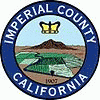Imperial County (Imperial County)
 |
Imperial County is located in the far southeast of California, in the Imperial Valley. It borders San Diego County to the west, Riverside County to the north, the U.S. state of Arizona to the east and the Mexican state of Baja California to the south. It includes the El Centro Metropolitan Statistical Area and is part of the Southern California border region, the smallest but most economically diverse region in the state.
Although this region is a desert, with high temperatures and low average rainfall of 3 in per year, the economy is strongly based on agriculture. This is supported by irrigation, with water supplied wholly from the Colorado River via the All-American Canal.
The Imperial Valley straddles the border between the United States and Mexico. Imperial County is strongly influenced by Mexican culture. Approximately 80% of the county's population is Hispanic, with the vast majority being of Mexican origin. The remainder of the population is predominantly non-Hispanic white, in addition to smaller African American, Native American, and Asian minorities.
Spanish explorer Melchor Díaz was one of the first Europeans to visit the area of the Imperial Valley in 1540. The explorer Juan Bautista de Anza also explored the area in 1776.
Decades later, after the Mexican–American War, the northern half of the valley was annexed in 1848 by the U.S., while the southern half remained under Mexican rule. Small-scale settlement in natural aquifer areas had occurred in the early 19th century (the present-day site of Mexicali), but most permanent settlement (Americans on the U.S. side, Mexicans on the other side) was after 1900.
In 1905, torrential rainfall in the American Southwest caused the Colorado River (the only drainage for the region) to flood, including canals that had been built to irrigate the Imperial Valley. Since the valley is partially below sea level, the waters never fully receded, but collected in the Salton Sink in what is now called the Salton Sea.
Imperial County was formed in 1907 from the eastern portion of San Diego County. The county was named for Imperial Valley. This had been named for the Imperial Land Company, a subsidiary of the California Development Company, which at the turn of the 20th century had claimed the southern portion of the Colorado Desert for agriculture. The Imperial Land Company also owned extensive lands in Mexico (Baja California). Its objective was to develop commercial crop farming.
By 1910, the land company had managed to settle and develop thousands of farms on both sides of the border. The Mexican Revolution soon after severely disrupted the company's plans. Rival Mexican armies affiliated with different ethnicities killed nearly 10,000 farmers and their families in northern Mexico. Not until the 1920s was the other side of California in the United States sufficiently peaceful and prosperous for the company to earn a return for a large percentage of Mexicans. Some chose to stay and create roots in newly developed communities in the valley.
During the Great Depression and the Dust Bowl, the county attracted migrating "Okies" from drought-ridden farms on the plains by the need of migrant labor. More prosperous job-seekers also arrived from across the U.S. in the 1930s and 1940s. American entry into World War II stimulated the growth of jobs and need to expanded agriculture, and the All American Canal was completed from its source, the Colorado River, to Imperial Valley from 1948 to 1951. By the 1950 census, more than 50,000 residents lived in Imperial County alone, about 40 times the population of 1910. Most of the population was year-round, but would increase every winter by migrant laborers from Mexico. Until the 1960s, the farms in Imperial County provided substantial economic returns to the company and the valley.
Map - Imperial County (Imperial County)
Map
Country - United_States
 |
 |
| Flag of the United States | |
Indigenous peoples have inhabited the Americas for thousands of years. Beginning in 1607, British colonization led to the establishment of the Thirteen Colonies in what is now the Eastern United States. They quarreled with the British Crown over taxation and political representation, leading to the American Revolution and proceeding Revolutionary War. The United States declared independence on July 4, 1776, becoming the first nation-state founded on Enlightenment principles of unalienable natural rights, consent of the governed, and liberal democracy. The country began expanding across North America, spanning the continent by 1848. Sectional division surrounding slavery in the Southern United States led to the secession of the Confederate States of America, which fought the remaining states of the Union during the American Civil War (1861–1865). With the Union's victory and preservation, slavery was abolished nationally by the Thirteenth Amendment.
Currency / Language
| ISO | Currency | Symbol | Significant figures |
|---|---|---|---|
| USD | United States dollar | $ | 2 |
| ISO | Language |
|---|---|
| EN | English language |
| FR | French language |
| ES | Spanish language |

















